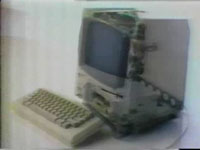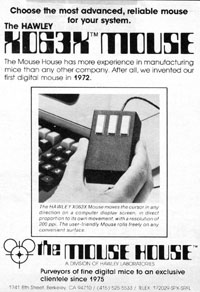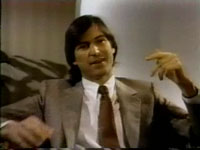 (still from Gartner
Group report)
(still from Gartner
Group report)The "1984" commercial is the best-known part of Apple's effort to market the Macintosh. Directed by Ridley Scott (whose movies Alien and Blade Runner were already science-fiction classics), broadcast only once (except for one earlier broadcast, and endless repeats), the commercial is still instantly recognizable. (See it on the Chiat/Day Web site.)
 (still from Gartner
Group report)
(still from Gartner
Group report)
But the rest of the Macintosh marketing campaign, though less clearly-remembered, may have been more influential over the long run. The Macintosh introduction brought a new level of sophistication to high-technology marketing. It introduced a set of practices that have been widely emulated in Silicon Valley, and advanced the careers of several high-profile marketing experts. In some small measure, it even helped change the way people think about computers. Some of these techniques had been used in earlier product introductions, but their combination, and the quality of their execution, put the Macintosh introduction in a class by itself.
The personal computer industry in the 1970s and early 1980s catered mainly to hobbyists and "early adopters" (people who were willing to take on the challenge of learning about computers in order to realize major productivity gains at work); consumer marketing was virtually unheard-of. (Mainframe computers, of course, were never consumer products: they were sold to corporations, government and military agencies, and universities.) Products were introduced with little fanfare, and marketing efforts were directed almost exclusively at the trade press and industry insiders.
 (advertisement
for mouse, c. 1980)
(advertisement
for mouse, c. 1980)
This in turn affected high-tech journalism. Covering the computer industry, San Jose Mercury News reporter Evelyn Richards remembered, "was just like covering any other industry-- steel, or automobiles. Actually, it wasn't even as prominent as automobiles." New product announcements, she continued, "were very techie: they focused on bits and bytes and the operating system, and how many megabits of memory a machine had. Their press releases were pretty unreadable.... It was just industry insiders; it wasn't really consumer-focused."
Apple itself had enjoyed great success marketing the Apple II to computer enthusiasts, and enjoyed a reputation as one of the more approachable computers for non-technical users; but it was clear that its future growth required reaching out to larger markets. The hiring of Pepsi CEO John Sculley had been one more in that direction. New versions of the Apple II (the Apple IIe, and Apple IIc) aimed at more general markets gave the company experience in conducting broader advertising campaigns. But the Apple II was a well-established platform; marketing an entirely new technology would require more intensive efforts.
All the marketing-related primary documents are listed on a separate page. A good place to start is with a short extract from Regis McKenna's classic book Relationship Marketing, which describing the Macintosh introduction. It provides an excellent overview of Apple's position going into 1984, and the key messages the Macintosh team sought to communicate. (A distillation of McKenna's strategic marketing principles, and the tactics his group developed to get them into public circulation, is also available.) Another inside views of the Macintosh launch is available in the Interview with Andy Cunningham, the McKenna consultant who worked on the Macintosh.
Apple, like many companies, devoted considerable effort to maintaining its corporate image. One tactic involved presenting writers with material on the company, like Jean Richardson and Rene White's 1980 "Apple Computer" corporate backgrounder. Another involved regulating press access to Apple employees, and vice versa: Barbara Krause's Inquiries from the Press summarizes company policy.
Lou Weiss' Focus Groups on Macintosh Experience, based on a video presentation of the results of focus group research, gives a sense of the strengths and weaknesses Apple marketing felt it had to deal with in the rollout.
For the truly serious, the Macintosh Product Introduction Plan (7 October 1983) offers a comprehensive overview of the strategic marketing effort, with a focus on the initial rollout.
 (Steve Jobs)
(Steve Jobs)
How well were the Macintosh's key marketing messages picked up by the press? The Gartner Group's "Evolution of a Computer" series featured in-depth stories on Apple computer, the computer's creators, the Macintosh factory, the marketing program, the educational market, and the overseas market. The major marketing themes Regis McKenna and Apple outlined echo throughout the series.
One notable element of the campaign were the public accolades given to members of the design team. With very few exceptions, hardware designers, software engineers, and others receive little public attention in marketing campaigns; IBM's elaborate 1983 rollout of the IBM PCjr included no special material on the computer's developers. In contrast, Macintosh engineers were almost treated like rock stars-- featured in a Rolling Stone article, photographed by a team that had worked with Fleetwood Mac. Chris Espinosa has donated copies of these pictures, while Andy Cunningham describes what turning software developers into corporate representatives was like.
What did the journalists who covered the Macintosh introduction think of all this effort? The Interview with Evelyn Richards offers the perspective of a veteran technology journalist on the regime of sneak previews and multiple exclusives.